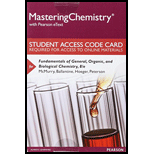
Interpretation: The charge of the given ion to be predicted.
Concept Introduction:
Electron configuration: The distribution of electrons of an atom or molecule in atomic or molecular orbitals.
Formation of ions:
Atom possesses equal number of protons and electrons and remains electrically neutral. By gaining (accepting electrons) or losing (donating electrons) one or more electrons, converts the neutral atom into a charged particle called IONS.
Cation: The loss of one or more electrons by a neutral atom leaves the atom positively charged ion called cation.
Anion: The gain of one or more electrons by a neutral atom leaves the neutral atom negatively charged ion called anion.
The symbolic representation of ions:
The electrons are reside in the principal quantum number ‘n’; by losing and gaining electron, reduces and increases in the electron count in the electronic configuration of the atom; for a cation adding positive charge as a superscript to the symbol of the element and for the anion adding negative charge as superscript to the symbol of the element.
Want to see the full answer?
Check out a sample textbook solution
Chapter 3 Solutions
Mastering Chemistry with Pearson eText -- Standalone Access Card -- for Fundamentals of General, Organic, and Biological Chemistry (8th Edition)
- What are weak electrostatic bonds that result in a partial sharing of hydrogen atoms between reacting groups?arrow_forwardwhat is a weak bond between hydrogen atom with a partial positive charge(usually O or N) and electronegative atom with a partial negative charge?arrow_forwardif a tomato juice has a pH of 3, how many more H+ ions are present in lemon juice with a pH of 2?arrow_forward
- what are the parts of an atom located? What is the structure? what are these subatomic particles give to an atom?arrow_forwardHow many electrons are in the outer shell of each of the following atoms?arrow_forwardWhich electron shell is the valence shell of an atom, and what is its significance?arrow_forward
 Biology Today and Tomorrow without Physiology (Mi...BiologyISBN:9781305117396Author:Cecie Starr, Christine Evers, Lisa StarrPublisher:Cengage Learning
Biology Today and Tomorrow without Physiology (Mi...BiologyISBN:9781305117396Author:Cecie Starr, Christine Evers, Lisa StarrPublisher:Cengage Learning Principles Of Radiographic Imaging: An Art And A ...Health & NutritionISBN:9781337711067Author:Richard R. Carlton, Arlene M. Adler, Vesna BalacPublisher:Cengage Learning
Principles Of Radiographic Imaging: An Art And A ...Health & NutritionISBN:9781337711067Author:Richard R. Carlton, Arlene M. Adler, Vesna BalacPublisher:Cengage Learning Biology: The Dynamic Science (MindTap Course List)BiologyISBN:9781305389892Author:Peter J. Russell, Paul E. Hertz, Beverly McMillanPublisher:Cengage Learning
Biology: The Dynamic Science (MindTap Course List)BiologyISBN:9781305389892Author:Peter J. Russell, Paul E. Hertz, Beverly McMillanPublisher:Cengage Learning Biology (MindTap Course List)BiologyISBN:9781337392938Author:Eldra Solomon, Charles Martin, Diana W. Martin, Linda R. BergPublisher:Cengage Learning
Biology (MindTap Course List)BiologyISBN:9781337392938Author:Eldra Solomon, Charles Martin, Diana W. Martin, Linda R. BergPublisher:Cengage Learning




